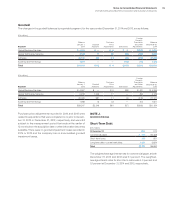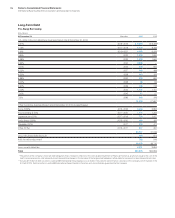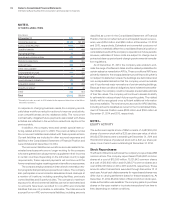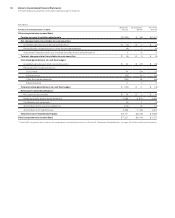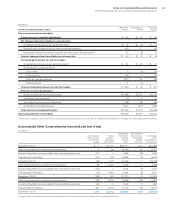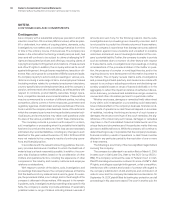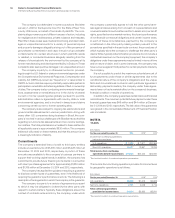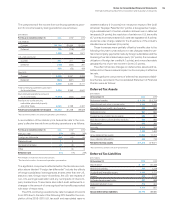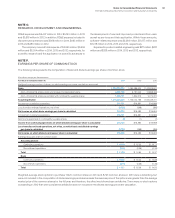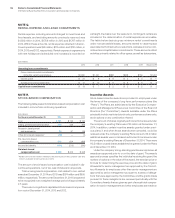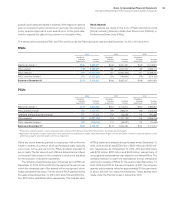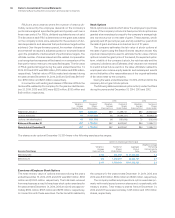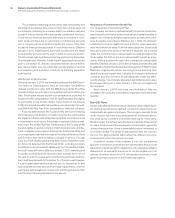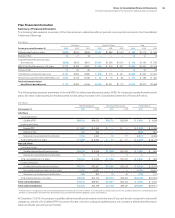IBM 2014 Annual Report Download - page 125
Download and view the complete annual report
Please find page 125 of the 2014 IBM annual report below. You can navigate through the pages in the report by either clicking on the pages listed below, or by using the keyword search tool below to find specific information within the annual report.
Notes to Consolidated Financial Statements
International Business Machines Corporation and Subsidiary Companies
124
the company customarily agrees to hold the other party harm-
less against losses arising from a breach of representations and
covenants related to such matters as title to assets sold, certain IP
rights, specified environmental matters, third-party performance
of nonfinancial contractual obligations and certain income taxes.
In each of these circumstances, payment by the company is
conditioned on the other party making a claim pursuant to the
procedures specified in the particular contract, the procedures of
which typically allow the company to challenge the other party’s
claims. While typically indemnification provisions do not include a
contractual maximum on the company’s payment, the company’s
obligations under these agreements may be limited in terms of time
and/or nature of claim, and in some instances, the company may
have recourse against third parties for certain payments made by
the company.
It is not possible to predict the maximum potential amount of
future payments under these or similar agreements due to the
conditional nature of the company’s obligations and the unique
facts and circumstances involved in each particular agreement.
Historically, payments made by the company under these agree-
ments have not had a material effect on the company’s business,
financial condition or results of operations.
In addition, the company guarantees certain loans and financial
commitments. The maximum potential future payment under these
financial guarantees was $46 million and $44 million at Decem-
ber31, 2014 and 2013, respectively. The fair value of the guarantees
recognized in the Consolidated Statement of Financial Position
was immaterial.
NOTE N.
TA XES
($ in millions)
For the year ended December 31: 2014 2013*2012*
Income from continuing operations
before income taxes
U.S. operations $ 7,509 $ 7,577 $10,306
Non-U.S. operations 12,477 12,667 12,234
Total income from continuing
operations before income taxes $19,986 $20,244 $22,540
* Reclassified to reflect discontinued operations presentation.
The income from continuing operations provision for income taxes
by geographic operations is as follows:
($ in millions)
For the year ended December 31: 2014 2013*2012*
U.S. operations $2,093 $1,315 $2,825
Non-U.S. operations 2,141 2,048 2,716
Total continuing operations
provision for income taxes $4,234 $3,363 $5,541
* Reclassified to reflect discontinued operations presentation.
The company is a defendant in numerous actions filed after
January 1, 2008 in the Supreme Court for the State of New York,
county of Broome, on behalf of hundreds of plaintiffs. The com-
plaints allege numerous and different causes of action, including
for negligence and recklessness, private nuisance and trespass.
Plaintiffs in these cases seek medical monitoring and claim dam-
ages in unspecified amounts for a variety of personal injuries
and property damages allegedly arising out of the presence of
groundwater contamination and vapor intrusion of groundwater
contaminants into certain structures in which plaintiffs reside
or resided, or conducted business, allegedly resulting from the
release of chemicals into the environment by the company at its
former manufacturing and development facility in Endicott. These
complaints also seek punitive damages in an unspecified amount.
The company is party to, or otherwise involved in, proceed-
ings brought by U.S. federal or state environmental agencies under
the Comprehensive Environmental Response, Compensation and
Liability Act (CERCLA), known as “Superfund,” or laws similar to
CERCLA. Such statutes require potentially responsible parties to
participate in remediation activities regardless of fault or ownership
of sites. The company is also conducting environmental investiga-
tions, assessments or remediations at or in the vicinity of several
current or former operating sites globally pursuant to permits,
administrative orders or agreements with country, state or local
environmental agencies, and is involved in lawsuits and claims
concerning certain current or former operating sites.
The company is also subject to ongoing tax examinations and
governmental assessments in various jurisdictions. Along with
many other U.S. companies doing business in Brazil, the com-
pany is involved in various challenges with Brazilian tax authorities
regarding non-income tax assessments and non-income tax litiga-
tion matters. The total potential amount related to these matters for
all applicable years is approximately $630 million. The company
believes it will prevail on these matters and that this amount is not
a meaningful indicator of liability.
Commitments
The company’s extended lines of credit to third-party entities
include unused amounts of $5,365 million and $5,028 million at
December31, 2014 and 2013, respectively. A portion of these
amounts was available to the company’s business partners to
support their working capital needs. In addition, the company has
committed to provide future financing to its clients in connection
with client purchase agreements for approximately $1,816 million
and $1,769 million at December31, 2014 and 2013, respectively.
The company has applied the guidance requiring a guarantor
to disclose certain types of guarantees, even if the likelihood of
requiring the guarantor’s performance is remote. The following is a
description of arrangements in which the company is the guarantor.
The company is a party to a variety of agreements pursuant
to which it may be obligated to indemnify the other party with
respect to certain matters. Typically, these obligations arise in the
context of contracts entered into by the company, under which



